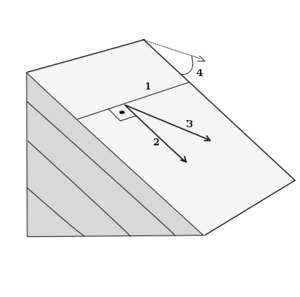Difference between revisions of "Strike"
Jump to navigation
Jump to search
FWhitehurst (talk | contribs) m (added Category:Geophysical methods using HotCat) |
Cwhitehurst (talk | contribs) |
||
| Line 1: | Line 1: | ||
| − | [[File:Dip.svg.png|thumbnail|{{figure number|1}}Strike and dip of the beds: 1-Strike, 2-Dip, 3-Apparent dip, 4-Angle of dip. Source: Wikipedia. Author: Eurico Zimbres.]] | + | [[File:Dip.svg.png|thumbnail|300px|{{figure number|1}}Strike and dip of the beds: 1-Strike, 2-Dip, 3-Apparent dip, 4-Angle of dip. Source: Wikipedia. Author: Eurico Zimbres.]] |
Strike, or [[azimuth]], is the orientation of a body or surface, measured where it intersects a horizontal plane. It is perpendicular to true [[dip]]. Strike is usually written as N25E, to distinguish it from dip, which is written 4S, 4SE, or 4 65SE. | Strike, or [[azimuth]], is the orientation of a body or surface, measured where it intersects a horizontal plane. It is perpendicular to true [[dip]]. Strike is usually written as N25E, to distinguish it from dip, which is written 4S, 4SE, or 4 65SE. | ||
Revision as of 20:47, 2 July 2014
Strike, or azimuth, is the orientation of a body or surface, measured where it intersects a horizontal plane. It is perpendicular to true dip. Strike is usually written as N25E, to distinguish it from dip, which is written 4S, 4SE, or 4 65SE.
Figure 1 illustrates the strike and dip of beds.
This article is a stub. You can help AAPG Wiki by expanding it.
